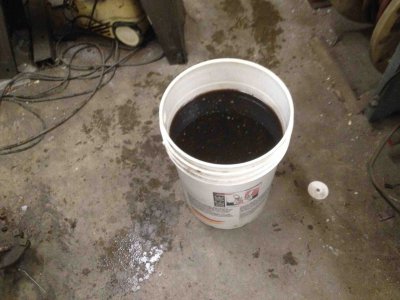Greg, I have read quite a bit about the process, and believe it is undesirable to have non-ferrous materials in the tank. This article mentions a plating effect of the electrode if there is brass, zinc, etc.....probably halting the rust reversal process.
http://myweb.tiscali.co.uk/andyspatch/rust.htm#non
Thanks for the link, this appears to be a quite good overall piece of writing on electrolytic cleaning of rust from iron. Your statement, "it is undesirable to have non-ferrous metals in the tank" is mostly correct, but not completely.
The reason the person starting this thread should not electrolytically clean rust from an object with brass or bronze bearings is that they can become plated with iron from the sacrificial anode. I have no idea how thick the iron plating will end up. However, brass or bronze will not corrode from being attached to a piece of iron being de-rusted this way.
Please ignore the rest of what I have to say if you aren't interested in the chemistry.
The author's statement:
"Please note that electrolytic cleaning is not suitable for non-ferrous metals such as copper, bronze, brass, pewter, tin or aluminium. The corrosion products found on these metals are rarely formed by electrolytic action and therefore the process cannot be reversed electrolytically."
is an odd sort of nonsense. The formation of metal corrosion products are all very similar, they are uniformly some kind of oxidation product which means the metal forms a positive ion (looses an electron*). This process can be nothing but reversible (that's not to say the reduced metal will adhere to the remaining undisturbed metal in any useful form). Aluminum is a special case because it can form both negative or positive ions. I don't know if it would be stable in the sort of reaction being performed in this de-rusting process. Since it can be attacked by either acids or bases my guess would be it would not fare well in the electrolyte being used here.
It may be correct that the process is ineffective for cleaning corrosion from copper-containing alloys, however the source that the author cites:
http://nautarch.tamu.edu/CRL/conservationmanual/
has a section which discusses safe conditions for that very process!:
"
ELECTROLYTIC REDUCTION CLEANING
Electrolytic reduction of cupreous metals is also carried out in the
same manner as described for iron. Either 2 percent sodium hydroxide or 5 percemt sodium carbonate can be used for the electrolyte. The latter is used most often, although acceptable results have also been achieved using 5 percent formic acid as the electrolyte. A mild steel anode can be used, but Type 316 stainless steel or platinized titanium is required if formic acid is used as the electrolyte. The same
electrolytic setups described for iron or for silver (below) are used."
Possibly the confusion centers around the outcomes. It appears that reduction of black rust restores the oxidized iron to a near-original state. On the other hand, the reduction of oxidized copper may simply remove the corroded material from the remaining metal:
"Jedrzejewska (1963:135) draws attention to the fact that stripping, especially by electrolysis, may destroy significant archaeological data such as tool marks, engraved lines, and decorative elements, as well as alter the original shape of the object."
There is no suggestion in this reference at least, that "electrolytic reduction cleaning" causes copper alloys in their native state (not already corroded) to be destroyed.
Disclaimer: I am not a metallurgist. However it does not seem possible to me that zinc could be "pulled out of" a non-porous alloy. It certainly will not happen at the cathode where the reduction is taking place. The author states:
"It is a good idea to avoid galvanised steel too, as it is important that no zinc, nickel, copper or similar metals get into the solution, as otherwise some plating of the cathode may occur."
But note the context in which this statement appears:
"The iron anode, or positive electrode, should be considered to be expendable and can be expected to rust as a result primarily of the presence of molecular oxygen combining with the iron. It is possible to use high grade stainless steel as an anode to reduce this, although the chromium present in stainless steel may produce poisonous chromium compounds in the electrolyte as it erodes which are considered dangerous and which will be illegal to dispose of down the drain in many areas. It is a good idea to avoid galvanised steel too, as it is important that no zinc, nickel, copper or similar metals get into the solution, as otherwise some plating of the cathode may occur."
He is plainly advising against the use of galvanized steel (or copper, or stainless steel) as the sacrificial anode because that will put ions other than iron into solution and may plate the object being cleaned at the cathode with these metals. As stated at the top, I would be concerned not with the brass bearings corroding in the cleaning process, but instead they may end up being plated with iron.
Walt
* Chemists have come to generalize "oxidation" as being the loss of an electron for a lot of reasons that are of no interest here, but the product may or may not end up containing the element oxygen. The reason the process is called oxidation is a historical remnant of the way the underlying process was discovered: oxygen is a powerful scavenger of electrons, and is abundant in our environment. As a result, all the early examples of this sort of electron transfer were things like iron rust, combustion of organic compounds and similar processes. Interestingly, elements from the same area of the periodic table cause similar chemical reactions. Free fluorine can cause spectacular fires in materials oxygen is relatively unreactive with.


